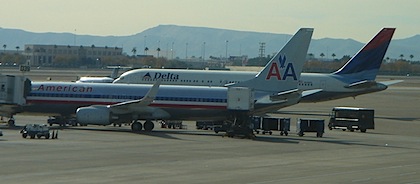The DaVinci Code-Share (Part 1)
Understanding Code Shared flights
A few years ago I saw the movie the ‘DaVinci Code’. I just did not get it. I found it extremely confusing and complex with interpretations of artwork that was about stories in the bible that in turn, I am not very familiar with. Code shared flights are a bit like that. They are flights sold by an airline that it does not operate. So, a flight number of a code shared flight number actually refers to another flight operated by another carrier, which has a real flight number given to it by the operating carrier. Yes, interpreting what the ‘chalice’ actually referred to in Michlangelo’s ‘Last Supper’ was easier to decipher… They tell me that I really need to read the book.
To a traveler, code-shares can be confusing and can add unintended complexity to your itinerary. In this two part article, I will go into the good, the bad and the ugly of Code Shares and tips to prevent challenges while flying on code-shared flights. In part 1 I will talk about Code shares and their benefits to travelers. In part 2, I will go into the issues and challenges faced by travelers on code-shared flights.
The importance of code-shares to Airlines:
Code shares are a very important tool used by airlines to increase their market coverage. It is a mechanism by which they can sell seats on a flight that they do not operate.
For example, US Airways or Continental do not fly a non-stop from Washington Dulles (IAD) to San Francisco (SFO). But United does. So, in order to be able to sell seats on these non-stop flights on this route, US Airways and Continental (and several other United and Star Alliance partners) have code shared this flight. For example, an IAD-SFO flight by United – UA 975 is also sold as code-shared flights CO6087 by Continental, US6583 by US Airways, LH9368 by Lufthansa, NZ9569 by Air New Zealand, OS7883 by Austrian and SK8793 by SAS.
Here are some Benefits to passengers of Code Shared flights:
Access to routes your airline does not fly:
The main reason airlines have code-share agreements with other airlines is so that they can sell tickets on routes they do not fly. This is also a great benefit to travelers. You can now purchase flights from your airline to destinations or routes they do not fly, as described in the example above. This becomes even more important when an airline signs a code-share agreement with airlines not in their alliance. For example, United airline has a code-share agreement with Qatar Airways. This gives United’s travelers access to routes not flown by any Star Alliance airline.
Credit card and website deals:
Some airlines offer special benefits or deals for booking tickets on their website. These range from miles for booking online to extra miles or even status miles for booking on their website using their branded credit card. With code-shared flights being sold with flight numbers of my preferred airline, you can now get these benefits and deals for purchasing flight operated by other airline partners too. Continuing my example from above, thanks to the availability of code-shared flights, I can get double award miles and also status miles (EQM) on United MileagePlus for purchasing flights operated by Qatar Airways on united.com, using by United Visa card. Finding the flight on United.com is another story, for another post…
Using vouchers and unused credits:
This is a case where code shares are invaluable. If you have any vouchers given to you by an airline (for compensation, for example) or any unused tickets, you can only redeem them on flights that are sold by the airline issuing the voucher or unused ticket. But, thanks to code shared flights, these flights can be operated by any partner, as long as it is code shared. I personally had a situation where I had an unused ticket for a flight I had purchased from US Airways. The flight I needed to finally take was operated by United. When I checked on US Airways’ website, I saw that the flight was offered as a code-shared flight by US Airways. I was able to purchase the United flight from US Airways, using my US Airways issued unused ticket.
Corporate preferences:
For some business travelers, their corporations may have a corporate mandate on which airline they should fly. For such travelers, code-shares are great as they greatly extend the routes available to them. I know of business traveler whose company requires him to fly Delta Airlines. He greatly appreciates all the code share agreements Delta has with other airlines, such as Jet Airways of India.
In part 2 of this article, I will go into challenges code-shares bring to travelers. These include issues with upgrades, customer service, terminal changes on connections, booking errors, etc. I will also provide advice that will help travelers when flying on code-shared flights.
Your experiences with Code-Shared flights:
If anyone has any experiences to share, positive or negative, when flying code shared flights, please share by leaving a comment below.
You can also get regular updates via email or RSS by clicking on the RSS link here. Do follow us onTwitter and Facebook for updates on Airlines, Airline Miles and other Loyalty Programs

Don’t bother reading the Da Vinci code, I read the book and watched the movie. I understand code-share flights more. Thanks for helping give a better understanding.
I will take your advice on the book! Thank you for your kind words on the article. I am glad to help with your understanding of code-shares.